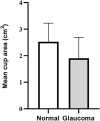Glaucoma diagnosis using multi-feature analysis and a deep learning technique
- PMID: 35577876
- PMCID: PMC9110703
- DOI: 10.1038/s41598-022-12147-y
Glaucoma diagnosis using multi-feature analysis and a deep learning technique
Abstract
In this study, we aimed to facilitate the current diagnostic assessment of glaucoma by analyzing multiple features and introducing a new cross-sectional optic nerve head (ONH) feature from optical coherence tomography (OCT) images. The data (n = 100 for both glaucoma and control) were collected based on structural, functional, demographic and risk factors. The features were statistically analyzed, and the most significant four features were used to train machine learning (ML) algorithms. Two ML algorithms: deep learning (DL) and logistic regression (LR) were compared in terms of the classification accuracy for automated glaucoma detection. The performance of the ML models was evaluated on unseen test data, n = 55. An image segmentation pilot study was then performed on cross-sectional OCT scans. The ONH cup area was extracted, analyzed, and a new DL model was trained for glaucoma prediction. The DL model was estimated using five-fold cross-validation and compared with two pre-trained models. The DL model trained from the optimal features achieved significantly higher diagnostic performance (area under the receiver operating characteristic curve (AUC) 0.98 and accuracy of 97% on validation data and 96% on test data) compared to previous studies for automated glaucoma detection. The second DL model used in the pilot study also showed promising outcomes (AUC 0.99 and accuracy of 98.6%) to detect glaucoma compared to two pre-trained models. In combination, the result of the two studies strongly suggests the four features and the cross-sectional ONH cup area trained using deep learning have a great potential for use as an initial screening tool for glaucoma which will assist clinicians in making a precise decision.
© 2022. The Author(s).
Conflict of interest statement
The authors declare no competing interests.
Figures





Similar articles
-
Deep Learning-based Diagnosis of Glaucoma Using Wide-field Optical Coherence Tomography Images.J Glaucoma. 2021 Sep 1;30(9):803-812. doi: 10.1097/IJG.0000000000001885. J Glaucoma. 2021. PMID: 33979115
-
Assessment of a Segmentation-Free Deep Learning Algorithm for Diagnosing Glaucoma From Optical Coherence Tomography Scans.JAMA Ophthalmol. 2020 Apr 1;138(4):333-339. doi: 10.1001/jamaophthalmol.2019.5983. JAMA Ophthalmol. 2020. PMID: 32053142 Free PMC article.
-
Using Deep Learning and Transfer Learning to Accurately Diagnose Early-Onset Glaucoma From Macular Optical Coherence Tomography Images.Am J Ophthalmol. 2019 Feb;198:136-145. doi: 10.1016/j.ajo.2018.10.007. Epub 2018 Oct 12. Am J Ophthalmol. 2019. PMID: 30316669
-
Deep learning in glaucoma with optical coherence tomography: a review.Eye (Lond). 2021 Jan;35(1):188-201. doi: 10.1038/s41433-020-01191-5. Epub 2020 Oct 7. Eye (Lond). 2021. PMID: 33028972 Free PMC article. Review.
-
Deep learning in optical coherence tomography: Where are the gaps?Clin Exp Ophthalmol. 2023 Nov;51(8):853-863. doi: 10.1111/ceo.14258. Epub 2023 May 28. Clin Exp Ophthalmol. 2023. PMID: 37245525 Free PMC article. Review.
Cited by
-
CSDNet: A Novel Deep Learning Framework for Improved Cataract State Detection.Diagnostics (Basel). 2024 May 8;14(10):983. doi: 10.3390/diagnostics14100983. Diagnostics (Basel). 2024. PMID: 38786279 Free PMC article.
-
Explainable AI for Retinoblastoma Diagnosis: Interpreting Deep Learning Models with LIME and SHAP.Diagnostics (Basel). 2023 Jun 1;13(11):1932. doi: 10.3390/diagnostics13111932. Diagnostics (Basel). 2023. PMID: 37296784 Free PMC article.
-
Applications of machine learning in glaucoma diagnosis based on tabular data: a systematic review.BMC Biomed Eng. 2025 Aug 1;7(1):9. doi: 10.1186/s42490-025-00095-3. BMC Biomed Eng. 2025. PMID: 40745560 Free PMC article.
-
Lights and Shadows on Artificial Intelligence in Glaucoma: Transforming Screening, Monitoring, and Prognosis.J Clin Med. 2025 Mar 21;14(7):2139. doi: 10.3390/jcm14072139. J Clin Med. 2025. PMID: 40217589 Free PMC article. Review.
-
An overview of artificial intelligence in diabetic retinopathy and other ocular diseases.Front Public Health. 2022 Oct 28;10:971943. doi: 10.3389/fpubh.2022.971943. eCollection 2022. Front Public Health. 2022. PMID: 36388304 Free PMC article. Review.
References
-
- Al-Aswad LA. Glaucoma Today. Bryn Mawr Communications; 2017.
Publication types
MeSH terms
LinkOut - more resources
Full Text Sources
Medical

